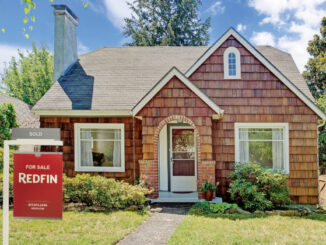
Higher home prices and sharply higher mortgage rates have reduced buyer activity.
- Existing-home sales fell for the third straight month to a seasonally adjusted annual rate of 5.61 million. Sales fell 2.4% from March and 5.9% from a year earlier.
- With slower demand, the inventory of unsold existing homes climbed to 1.03 million by the end of April, or the equivalent of 2.2 months of the monthly sales pace.
- The median existing-home sales price increased at a slower year-over-year pace of 14.8% to $391,200.
Sales of existing homes posted a third straight monthly decline, slipping 2.4% from March, the National Association of Realtors said Thursday.
Month-over-month sales were split among the four major U.S. regions, with two areas posting gains and two experiencing declines in April. Year-over-year sales struggled, as each of the four regions reported dips.
Total existing-home sales — completed transactions that include single-family homes, townhomes, condominiums, and co-ops — slid 2.4% from March to a seasonally adjusted annual rate of 5.61 million in April, NAR said. Year-over-year, sales dropped 5.9% from 5.96 million in April 2021.
“Higher home prices and sharply higher mortgage rates have reduced buyer activity,” said Lawrence Yun, NAR’s chief economist. “It looks like more declines are imminent in the upcoming months, and we’ll likely return to the pre-pandemic home sales activity after the remarkable surge over the past two years.”
Total housing inventory at the end of April was 1.03 million units, up 10.8% from March but down 10.4% from a year ago (1.15 million). Unsold inventory sits at a 2.2-month supply at the current sales pace, up from 1.9 months in March but down from 2.3 months in April 2021, NAR said.
“Housing supply has started to improve, albeit at an extremely sluggish pace,” Yun said.
He also noted the rare state of the current marketplace. “The market is quite unusual, as sales are coming down but listed homes are still selling swiftly, and home prices are much higher than a year ago,” he said.
“Moreover, an increasing number of buyers with short tenure expectations could opt for five-year adjustable-rate mortgages, thereby assuring fixed payments over five years because of the rate reset,” Yun added. “The cash buyers, not impacted by mortgage rate changes, remain elevated.”
The median existing-home price for all housing types in April was $391,200, up 14.8% from April 2021 ($340,700), as prices increased in each region. This continued the string of consecutive months of year-over-year increases to 122, the longest-running streak on record.
Properties typically remained on the market for 17 days in April, ther same as in March 2022 and April 2021. Of the homes sold April 2022, 88% were on the market for less than a month.
First-time buyers were responsible for 28% of sales in April, down from 30% in March and from 31% in April 2021. NAR’s 2021 Profile of Home Buyers and Sellers — released in late 20214 — reported that the annual share of first-time buyers was 34%.
All-cash sales accounted for 26% of transactions in April, down from 28% in March and up from the 25% recorded in April 2021.
Individual investors or second-home buyers, who make up many cash sales, purchased 17% of homes in April, down from 18% in March and equal to 17% in April 2021, NAR said.
Distressed sales — consisting of foreclosures and short sales — represented less than 1% of sales in April, the same as in March but down from 2% in April 2021.
According to Freddie Mac, the average commitment rate for a 30-year, conventional, fixed-rate mortgage was 4.98% in April, up from 4.17% in March. The average commitment rate across all of 2021 was 2.96%.
Realtor.com’s Market Trends Report in April shows that the largest year-over-year median list price growth occurred in Miami (+38.3%), Las Vegas (+32.6%), and Orlando (+30.7%). Austin, Texas, reported the highest growth in the share of homes that had their prices reduced compared to last year (+6.8 percentage points), followed by Las Vegas (+5.3 percentage points) and Sacramento (+4.7 percentage points).
Single-family and Condo/Co-op Sales
Single-family home sales decreased to a seasonally adjusted annual rate of 4.99 million in April, down 2.5% from 5.12 million in March and down 4.8% from a year earlier. The median existing single-family home price was $397,600 in April, up 14.8% from April 2021.
Existing condominium and co-op sales were recorded at a seasonally adjusted annual rate of 620,000 units in April, down 1.6% from March and down 13.9% from one year ago. The median existing condo price was $340,000 in April, an annual increase of 13.1%.
“As we find ourselves in the midst of a massive housing shortage, NAR continues to work with leaders across the private and public sectors to help close this deficit,” said NAR President Leslie Rouda Smith, a Realtor from Plano, Texas, and a broker associate at Dave Perry-Miller Real Estate in Dallas. “As the nation’s largest real estate association, we are urging policymakers to enact zoning reforms, homebuilder incentives, and other necessary regulations to help correct this situation.”
Regional Breakdown
Existing-home sales in the Northeast rose 1.5% in April, reaching an annual rate of 670,000, a 10.7% drop from April 2021. The median price in the Northeast was $412,100, up 8.1% from one year ago.
Sales in the Midwest grew 3.1% from the prior month to an annual rate of 1.3 million in April, a 1.5% slide from April 2021. The median price in the Midwest was $282,000, an 8.7% increase from one year ago.
Existing-home sales in the South fell 4.6% in April, posting an annual rate of 2.49 million, which represents a decrease of 5.7% from one year ago. The median price in the South was $352,100, a 22.2% climb from one year prior. For the eighth consecutive month, the South recorded the highest pace of price appreciation in comparison to the other three regions. Additionally, the South is the only region to report year-over-year double-digit price gains.
Sales in the West dipped 5.8% compared to the previous month, registering an annual rate of 1,14 million in April, down 8.1% from one year ago. The median price in the West was $523,000, up 4.3% from April 2021.
Joel Kan, assistant vice president of Economic and Industry Forecasting for the Mortgage Bankers Association, noted that the overall 5.6 million-unit sales pace for existing homes is the slowest since the spring of 2020, and said that while higher prices and higher mortgage rates continue to negatively affect sales, there are other factors.
“Although the job market is still extremely strong, emerging signs of economic weakness have also added to the overall uncertainty for potential homebuyers,” Kan said.
“Inventory is a key component of housing market conditions, and the limited availability of homes for sale has been adding to upward pressure on prices, delaying some purchase activity,” he added. “While there was a slight increase in the number of homes for sale to just over 1 million units, this was likely due to the declining sales pace as demand slows. At just over a two-month supply, inventory is still extremely low by historical standards, and the recent slowdown in residential construction activity may prolong this shortage.”
The National Association of Realtors® is America’s largest trade association, representing more than 1.5 million members involved in all aspects of the residential and commercial real estate industries.
Source: Nationalmortgageprofessional.com



